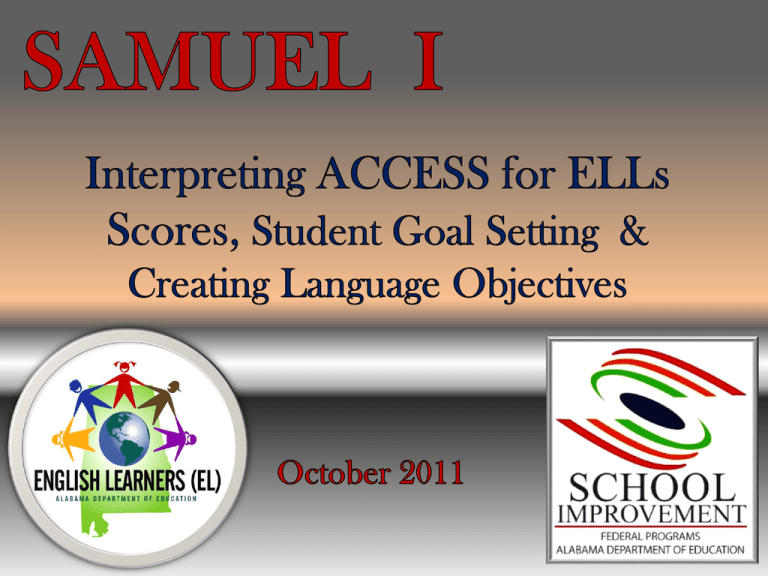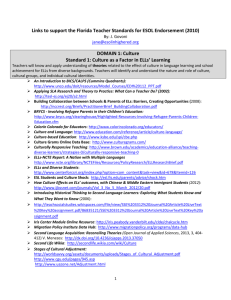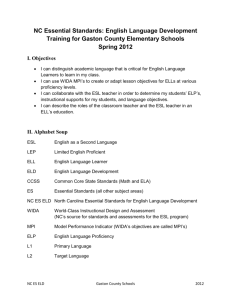SAMUEL I, 2011-12 Presentation Posted
advertisement

We will: •Provide an overview of how to interpret ACCESS for ELLs scores for instructional purposes. •Review the importance of student goal setting and learn how to write instructional goals for EL students. •Learn to write language objectives and find practical ways of incorporating language objectives into lesson plans. OBJECTIVE ONE •Provide a basic understanding of WIDA and ACCESS for ELLs •Provide an overview of how to interpret ACCESS for ELLs scores for instructional purposes to better understand our students’ Listening, Speaking, Reading, Writing, and Overall English Proficiency Levels. ACCESS for ELLs: JUST ANOTHER STANDARDIZED TEST? World-Class Instructional Design & Assessment (WIDA) Consortium Five WIDA ELP Standards Standard 1- English language learners communicate for SOCIAL AND INSTRUCTIONAL purposes within the school setting. Standard 2 – English language learners communicate information, ideas, and concepts necessary for academic success in the content area of LANGUAGE ARTS. Standard 3 –English language learners communicate information, ideas, and concepts necessary for academic success in the content area of MATHEMATICS. Standard 4 –English language learners communicate information, ideas, and concepts necessary for academic success in the content area of SCIENCE. Standard 5 –English language learners communicate information, ideas, and concepts necessary for academic success in the content area of SOCIAL STUDIES. WIDA Consortium / CAL / MetriTech Four Language Domains Listening ─ process, understand, interpret, and evaluate spoken language in a variety of situations Speaking ─ engage in oral communication in a variety of situations for a variety of purposes and audiences Reading ─ process, interpret, and evaluate written language, symbols, and text with understanding and fluency Writing ─ engage in written communication in a variety of forms for a variety of purposes and audiences Five Grade-Level Clusters The WIDA ELP Standards are organized by the following Grade-Level clusters: •PreK−K •Grades 1−2 •Grades 3−5 •Grades 6−8 •Grades 9−12 Levels of English Language Proficiency 6 5 4 3 2 1 WIDA Consortium / CAL / MetriTech R E A C H I N G ACCESS for ELLs REPORTS TO INTERPRET • School Frequency Report • Student Roster Report • Teacher Report PROFICIENCY LEVELS 65 40 75 REPORTS TO INTERPRET • School Frequency Report (Grouped scores for grade level) • Student Roster Report • Teacher Report STUDENT ROSTER REPORTS REPORTS TO INTERPRET • School Frequency Report (Grouped scores for grade level) • Student Roster Report (Scores for grade level by individual students) • Teacher Report LANGUAGE DOMAINS REPORTS TO INTERPRET • School Frequency Report (Grouped scores for grade level) • Student Roster Report (Scores for grade level by individual students) • Teacher Report (Scores for individual students) OBJECTIVE ONE We will learn how to read the ACCESS for ELLs Report to better understand our students’ Listening, Speaking, Reading, Writing, and Overall English Proficiency Levels for instructional purposes. OBJECTIVE TWO We will learn how to use Proficiency Level data to maximize strengths and challenge weak areas through collaborative student goal setting with other faculty members for instructional purposes. HOW IS THIS DIFFERENT FROM WHAT I ALREADY DO? A man walks into a doctor’s office. He has a cucumber up his nose, a carrot in his left ear, and a banana in his right. “What’s the matter with me?” he asks the doctor. The doctor replies, “You’re not eating properly.” STUDENT ROSTER REPORTS TRENDS TABLE Student Watch List AMAO-A (.5 Growth) Student Name Juan 2009 2010 2011 Yes/No 2.3 2.4 3.0 Y Luis 1.9 2.1 2.3 N Karla 1.5 1.7 3.1 Y Student “Watch” List Luis Gloria 3.3 3.3 3.4 N Gloria Danael 2.2 2.7 4.2 Y Jonathon Jonathon 2.0 3.9 4.2 N Qi Ling Li 1.1 4.2 5.0 Y Now It’s Your Turn ACTIVITY: Make a Student “Watch” List • Use Student Scores and Trend Table Sheets • Compare student scores for the past 3 yrs • Make a watch list of students to target • Discuss with your table which language domain(s) each student would require intervention in. • Share findings in whole group STUDENT GOAL SETTING FORM STUDENT GOAL SETTING FORM (continued) TIER CHOICE USING STUDENT GOAL SETTING FORMS TO INFORM CLASSROOM INSTRUCTION QUESTIONS OR COMMENTS ABOUT STUDENT GOAL SETTING? ----ABOUT ANYTHING? LUNCH Objective Three We will learn how to use our students’ Proficiency Levels to create meaningful Language Objectives that each include a Language Function, Content Skill, and Differentiated English Learner Support to improve instructional practice. The play was a great success, but the audience was a disaster. I KNOW EXACTLY WHAT I’VE LOOKED ATDO ALL THE NUMBERS… ORMY I? STUDENTS NEED… -Oscar Wilde Purposes for Creating Language Objectives • To increase student’s content learning, regardless of their English level, through purposeful and differentiated supports. BICS (social) CALP (academic) BICS CALP Purposes for Creating Language Objectives • To increase students’ content learning, regardless of their English level, through varied and purposeful supports. • To provide a system for students to interact with content according to their academic language level and to increase that level through exposure and application. Academic Vocabulary (language Objective) Purposes for Creating Language Objectives • To increase students’ content learning, regardless of their English level, through varied and purposeful supports. • To provide a system for students to interact with content according to their academic language level and to increase that level through exposure and practice. • To plan explicitly students’ regular use and improvement in the domains of writing, speaking, listening and reading. 3 Parts of a Language Objective Language Function Content Stem Language Objective Support Language Function A language function describes what you expect the students to be able to do and how the students will communicate what they know. Language Functions Writing1.8 Level 1 Level 2 Level 3 Level 4 Level 5 Identify Follow Locate Name Listen Point Select Respond Circle Sort Label Draw Color Match Repeat Identify Follow Locate Describe Role play Predict Compare & Contrast Respond Classify Identify Describe Role play Predict Compare & Contrast Infer Sequence Illustrate Narrate Summarize Rewrite Interpret Identify Describe Predict Analyze Apply Compare & Contrast Infer Narrate Summarize Rewrite Depict Explain Categorize Predict Summarize Rewrite Paraphrase Analyze Apply Defend Persuade Debate Edit Revise Justify Create Generate Interpret Now It’s Your Turn ACTIVITY: Language Function Consensus • Use Handout Part C • Follow the handout directions with your table to practice choosing appropriate Language Functions from the chart • Be prepared to share one conversation your group had about which function to choose and why. Content Stem The content stem is what is being covered in class based on the Alabama Course of Study Support Supports are the tools or strategies you will provide to assist students in ACCESS for ELLs in using the language and knowledge required for the content. Sensory Supports Graphic Supports Interactive supports • • • • • • • • • • • • Charts • Graphic organizers • Tables • Graphs • Timelines • Number lines • • • • • • Real-life objects Manipulatives Picture/photos Illustrations Diagrams Drawings Videos Broadcasts Models Magazines Newspapers WIDA Consortium (pg. RG 21) Pairs/Partners Small groups Whole group Websites/software Native language Peers/mentors Support STAND. SIT. SHAKE HANDS. Language Arts Mathematics Science Social Studies • Illustrated word/phrase wall • Felt or magnetic figures of story elements • Sequence blocks • Environmental print • Posters, bulletin boards or displays • Audio books • Songs/Chants • Blocks/Cubes • Models of geometric figures • Calculators • Protractors, compasses • Rulers, yards/meter sticks • Counters • Coins • Scientific instruments • Physical models, • Measurement tools • Posters/ Illustrations of process or cycles • Actual substances, objects or organisms • Natural materials • • • • • Maps and Atlases Globes Compasses Timelines Multicultural artifacts/photo • Arial & satellite photographs • Video clips Support 3 Parts of a Language Objective Language Function Content Stem Language Objective Support SAMUEL I: THE BIG PICTURE Interpreting ACCESS for ELLs Student Goal Setting Language Objectives SAMUEL I: THE BIG PICTURE 1- Read the teacher report and highlight the weak areas 2-Fill in steps 4, 6 & 7 on the Student Goal Setting Form 3-Write any one language objective for this student. Contact Information • Dely V. Roberts – Title III/EL Specialist • droberts@alsde.edu • Dr. Tammy Hallman Starnes– Title III/EL Coordinator tstarnes@alsde.edu 5348 Gordon Persons Building--50 North Ripley Street Montgomery, AL--334-242-8199






